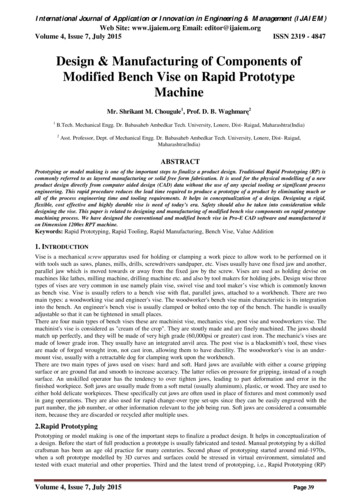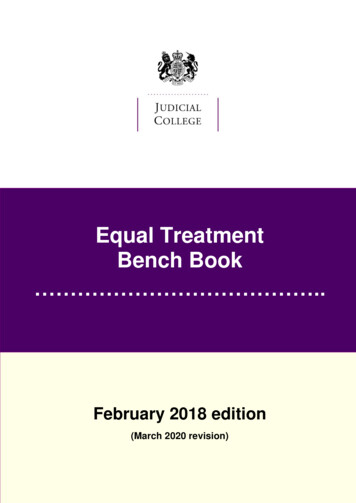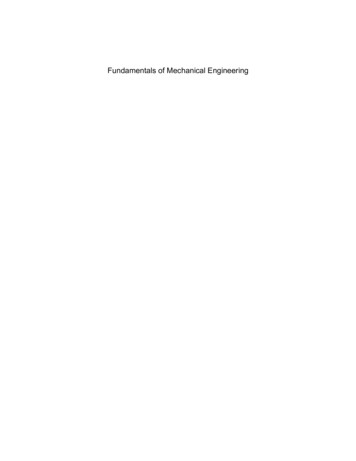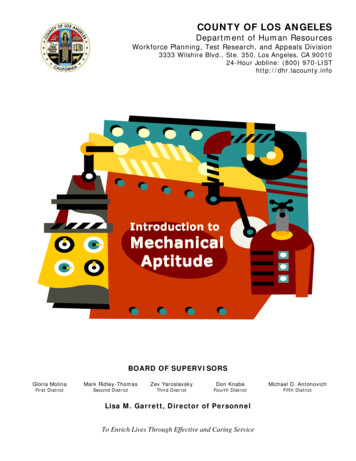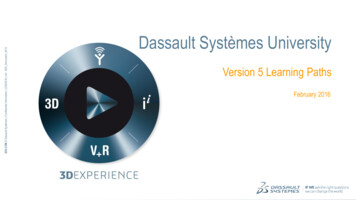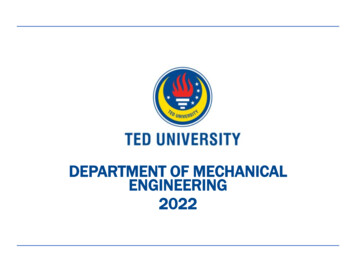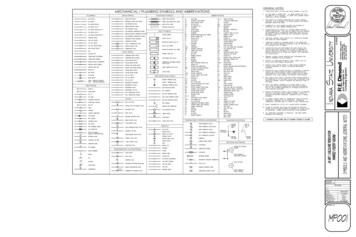
Transcription
A1. Mechanical BenchI. INTRODUCTION AND OBJECTIVE OF THE EXPERIMENTAn important part of mechanics relies on a certain amount of measurable quantities that werediscovered phenomenologically, before being given a mathematical definition. For instance, theconcepts of velocity and acceleration rely on the mathematical definitions of vectors and derivatives.Other concepts, such as forces, potential and kinetic energy, and more, are tied to the previousphenomenological concepts (e.g. friction) or fundamental equations (e.g. Newton's equation).This experiment will attempt to study a few different properties of motion, such as friction andgravitational force, and look at the elementary equations describing collisions. All of this will beachieved only by measuring speeds of a glider on an air-cushion bench.II. EXPERIMENTAL SETUPA glider represents the point mass, and moves on an air-cushion bench (fig. 1). In order to get decentquantitative results, it is necessary to reduce friction on the bench. This is made possible withincomfortable limits, by using pressurized air to make the glider hover. The bench's angle is adjusted byturning a screw located at one extremity; one turn of the screw results in an angle variation of0.001 radian. The glider's speeds can be measured using two optical gates: every time the glider goesthrough a gate, it blocks the laser's optical path, and a "Phywe" stopwatch measures the duration ofthis interruption (fig. 1). Knowing the time t of the interruption, and the glider's length a, we candetermine the glider's speed.v atAfter having launched the glider in position A, with an initial velocity v0 ,the optical gates 1 and 2 allowus to measure the following crossing times (the stopwatch's button '7' must be placed on position 3):- In the first direction (a), at position B, the time t 2a is measured, and thus v2a at gate 2,t1a is measured, and thus v1a at gate 1,- In the second direction (b), after the impact in D, at position C, the time t1b and speed v1b at gate 1,- In the direction (b), after the impact D, at B, the time t 2b and speed v2b at gate 2 are measured.- In the direction (a), at position C, the time
EPFL-TRAVAUX PRATIQUES DE PHYSIQUEA1-2Figure 1: The mechanical air-cushion bench, and the “Phywe” stopwatch.III. THEORYIII.1. PROPERTIES OF FRICTIONDespite the presence of air-cushions, some friction will still be present. We shall phenomenologicallydetermine the type of friction occurring, by choosing from the following three possibilities:sec- dry friction f fr , indépendante de la vitesse du mobile, mais en général proportionnelle à la forcenormaleN mgcos exercée par le mobile sur son supportf frsec K N K mg cos oùK le coefficient de frottement sec dynamiquelam- viscous friction in a laminar flow f fr (v) , that varies linearly with the speedf frlam (v) voù le coefficient de frottement visqueux laminairev(1)of the slider(2)- viscous friction in a turbulent flow f fr (v) , that varies quadratically with the speed v of the sliderturbf frturb (v) v2où le coefficient de frottement visqueux turbulent(3) coefficient depends on the penetration coefficient of the glider, the density of air ρ,and the apparent area of the glider S, according to the equation Cx S / 2 .Note that the
EPFL-TRAVAUX PRATIQUES DE PHYSIQUEA1-3III.2. MEASURING FRICTIONWe can measure the glider's energy variation between the points B and C. In the first direction (a), theglider's kinetic energy at point C is equal to that in B minus the energy dissipated through frictionbetween B and C plus the potential energy due to the height difference h between the two points. Ifthe average friction in the first direction (a) on a distance 𝐿2 between B and C is given bywrite:111mv1a 2 mv2a 2 faL 2 L2 mgh2 mv2a 2 faL 2 L2 mgL2 sin 222faL 2 , we can(4)Similarly, if is the average friction acting on the distance 𝐿2 between C and B in the second direction(b) isfbL 2 , we have:111mv2b 2 mv1b 2 fbL 2 L2 mgh2 mv1b 2 fbL 2 L2 mgL2 sin 222Adding (4) and (5) together yields an expression independent of the angle(5) 1111mv1a 2 mv2b 2 mv2a 2 mv1b 2 ( faL 2 fbL 2 )L22222from which we can easily deduce an average friction forcespeed vm f ( faL 2 fbL 2 ) / 2 v2a 2 v1b 2 v1a 2 v2b 2 4L 2 v 1 v v v v 2a1b1a2b 4 f for an for an average round-trip (6)III.3. RESTITUTION COEFFICIENT OF A COLLISIONIf the shock at point D is not perfectly elastic, part of the energy will be dissipated as heat in thesprings. If we define the kinetic energyaof the slider right before the impact, and the kinetic energyEcinbright after the impact, we can define the restitution coefficient of the collision C as the ratio ofEcinbaand EcinEcinCr bEcinaEcin(7)The kinetic energies before and after the impact can easily be extrapolated from the kinetic energiesmeasured at the point C11 a2C2C Ecin 2 mv1a f a L1 mgh1 2 mv1a f a L1 mgL1 sin E b 1 mv 2 f C L mgh 1 mv 2 f C L mgL sin b111bb11 cin 2 1b2Cwhere f aCand f b are the friction forces in the direction (a) and (b) at the point C . The restitutioncoefficient can be written:
EPFL-TRAVAUX PRATIQUES DE PHYSIQUEA1-41mv1b 2 fbC L1 mgL1 sin 2Cr 1mv1a 2 f aC L1 mgL1 sin 2(8)We notice that measuringCr will be easier if the bench is horizontal since sin 0 .III.4. MEASURING EARTH'S GRAVITATIONAL PULLSubtracting (5) from (4) yields:1111mv1a 2 mv2b 2 mv2a 2 mv1b 2 ( fbL 2 faL 2 )L2 2mgL2 sin 2222from which we can determine the gravitational acceleration gg 11v1b 2 v2b 2 v1a 2 v2 a 2 ( fbL 2 f aL 2 ) 4 L2 sin 2m sin (9)We notice that this measurement depends only weakly on the friction, since only the difference( fbL2 faL 2 ) appears in the expression. However, in order to get an appreciable precision on theobtained result, we will need to determine the phenomenological law governing friction precisely, aswell as the corresponding coefficient ( K, ou )III.5. CONSERVATION OF MOMENTUM DURING A COLLISIONWhen two objects collide, the total momentum is conserved. We can verify this law by using the aircushion bench in the horizontal position, and launching against one another two gliders A and B, ofmasses mA and mB , and initial velocities vA0 and vB0 (fig. 2). According to the the law of collisions,the momentum ( pa )before and ( pb )after the impact must be the same, independently of whether theshock is elastic or not. This leads to:pa mAvAa mBvBa mAvAb mBvBb pb(10)The speeds of A and B before ( vAa ,vBa )and after ( vAb ,vBb )can be determined from the speedsv1b ,v1a ,v2a ,v2b measured in the optical gates 1 and 2, using the following set of equations before theimpact1111mAvAa 2 mAv1a 2 A f aA and mB vBa 2 mB v2 a 2 B f aB2222ABwhere f a et f a are the friction forces acting on the gliders in the first direction (a) on the gliders Aand B, at gate 1 and 2.and after the impact:1111mAvAb 2 mAv1b 2 A fbA and mB vBb 2 mB v2b 2 B fbB2222
EPFL-TRAVAUX PRATIQUES DE PHYSIQUEAA1-5Bwhere f b and f b the friction forces acting on the gliders in the second direction (b) on the gliders Aand B, at gate 1 and 2.Figure 2- La configuration pour le test de la conservation de la quantité de mouvementThese equations can be approximated as:mAvAa mAv1a 1 A f aA 2 A f aA A f aA mv1 mv A 1a A 1a2 mAv1a 2v1a mAv1a A f aA mAv Aa mAv1a v1a A m v m v A fbA 1b A Abv1bandmB vBa mB v2 a andmB vBb mB v2b B f aBv2 a B fbBv2bin such a way that the law of collisions (10) can be well approximated by:pa mAv1a A f a Av1a mB v2 a B f aBv2 a mAv1b A fbAv1b mB v2b B fbBv2b pb(11)
EPFL-TRAVAUX PRATIQUES DE PHYSIQUEA1-6IV. SUGGESTED EXPERIMENTSIV.1. FrictionTurn on the air bench using the valve attached to the table leg. Set the bench in its horizontal position( 0 ). You can adjust and verify the horizontality using a slider. It’s very sensitive to any slightangle variation.Perform at least a dozen experiments with each one of the sliders, while making sure to change theinitial velocity every time, in order to get a wide enough range of measures. Each experiment thereforeyields the 4 speeds v1b ,v1a ,v2a ,v2b .- For each on of theses measures, determine the average frictionwhich is was measured according to equation (6).f and the average speed v atf versus v . Is the friction the same for all three sliders?secPhenomenologically, is the observed friction dry ( f fr K N K mg cos ), viscous (- Plot all results on a graph off frlam (v) v ), or turbulent ( f frturb (v) v2 ) ?- Determine the equation f fr f fr (v) by calculating the associatedK, ou coefficient for eachslider.IV.2. The restitution coefficientv1b ,v1a ,v2a ,v2b obtained previously, we can determine the restitution coefficient,knowing that 0 , using (8). Furthermore, having already determined the friction f fr f fr (v) inUsing the resultsCIV.1, we can replace the friction forces f aand f b with their expressions f a f fr (v1a ) andCCfbC f fr (v1b ) , such that 2mv1b 2L1 f fr (v1b ) Cr mv1a 2 2L1 f fr (v1a ) v1b 2 2L1Kgv1a 2 2L1Kgsif fr (v) Kmgv1b 2 2L1 v1b / mv1a 2 2L1 v1a / msif fr (v) vsif fr (v) v 2v1b 2 m 2L1 v1a 2 m 2L1 - For each of the three gliders, plotdoesCr as a function of the incident speed v1a . What parametersCr mainly depend on?IV.3. Gravitational accelerationThe bench is placed in an slanted position ( 0 , of the order of 5x10-3 radian). Perfmor at leasttwenty experiments with the steel spring slider. Once again, make sure to vary the initial speed everytime, in order to get a wide range of measures. Each experiment yields 4 different speedsv1b ,v1a ,v2a ,v2b , from which we can determine the gravitational acceleration g using equation (9), byestimating the friction term( fbL 2 faL 2 ) such that( fbL2 faL 2 ) using the relation f fr f fr (v) from paragraph IV.1, i.e.f fr (v1b ) f fr (v2b )2 f fr (v1a ) f fr (v2a )2
EPFL-TRAVAUX PRATIQUES DE PHYSIQUEg 1v1b 2 v2b 2 v1a 2 v2 a 2 4 L2 sin A1-7 0 v1b v2b v1a v2 a 4m sin 2222 4m sin v1b v2b v1a v2 a iff fr (v) Kmg cos iff fr (v ) viff fr (v) v 2- calculate the value g for each experiment, estimate the error made on this value, and indicate theideal measuring conditions for g .IV.4. The law of impactsUsing the setup of figure 2, we shall study the law of impacts (10) by verifying equation (11), in whichthe average friction f a , f a , f b and f b are to be estimated using the law f fr f fr (v) determinedAinparagraphIV.1.BABAgoodwayP pa pb / mA v1a v1b mB v2a P toproceedis v2b experimentally, i.e. todeterminetheratio 1 11 1 mA v1a v1b mB v2 a v2b Kg A mA B mB v1b v1a v2b v2 a if f fr (v) KmgmA v1a v1b mB v2 a v2b mA v1a v1b mB v2 a v2b mA v1a v1b mB v2 a v2b if f fr (v) vmA v1a v1b mB v2 a v2b A v1a v1b B v2 a v2b mA v1a v1b mB v2 a v2b if f fr (v) v 2v1b ,v1a ,v2a ,v2b for about 10 different experiments with the bench in a horizontalposition. Calculate the ratio pa pb / pa pb obtained in each one of these cases, supposingthat A B , and discuss the results.- measure the speedsFig. 3 : Image of the experimental setup
EPFL-TRAVAUX PRATIQUES DE PHYSIQUE A1-2 Figure 1: The mechanical air-cushion bench, and the "Phywe" stopwatch. III. THEORY III.1. PROPERTIES OF FRICTION . EPFL-TRAVAUX PRATIQUES DE PHYSIQUE A1-3 III.2. MEASURING FRICTION We can measure the glider's energy variation between the points B and C. In the first direction (a), the
